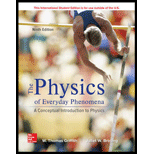
A bullet is fired into a block of wood sitting on a block of ice. The bullet has an initial velocity of 800 m/s and a mass of 0.007 kg. The wooden block has a mass of 1.3 kg and is initially at rest. The bullet remains embedded in the block of wood afterward.
- a. Assuming that momentum is conserved, find the velocity of the block of wood and bullet after the collision.
- b. What is the magnitude of the impulse that acts on the block of wood in this process?
- c. Does the change in momentum of the bullet equal that of the block of wood? Explain.
(a)
The velocity of the block of wood and bullet after collision.
Answer to Problem 2SP
The velocity of the block of wood and bullet after collision is
Explanation of Solution
Given info: The initial velocity of the bullet is
Write the expression for conservation of momentum.
Here,
Write the expression to find the initial momentum of the bullet.
Here,
Substitute
Write the expression to find the final momentum of the bullet and the wooden block.
Here,
Substitute
Write the expression for conservation of momentum.
Substitute
Conclusion:
Therefore, the velocity of the block of wood and bullet after collision is
(b)
The magnitude of the impulse that acts on the block of the wood.
Answer to Problem 2SP
The magnitude of the impulse that acts on the block of the wood is
Explanation of Solution
Write the expression for the final momentum of the wooden block.
Substitute
Write the expression for change in momentum of the wooden block.
Substitute
Write the expression of the impulse associated with the change in momentum.
Here,
Substitute
Conclusion:
Therefore, the magnitude of the impulse that acts on the block of the wood is
(c)
Whether the change in momentum of the bullet is equal to that of the block of the wood.
Answer to Problem 2SP
Yes, the magnitude of change in momentum of the bullet is equal to that of the block of the wood.
Explanation of Solution
Since the motion of the wooden block is due to the momentum imparted by the bullet, the magnitude of the change in momentum of the bullet is same as the change in momentum associated with the block of wood. The direction is opposite which facilitates the momentum conservation before and after the collision.
Conclusion:
Therefore, the magnitude of change in momentum of the bullet is equal to that of the block of the wood.
Want to see more full solutions like this?
Chapter 7 Solutions
Physics of Everyday Phenomena
- ! Required information Assume that the magnifier is held close to the eye. Use the standard near point of 25.0 cm to find the angular magnification. An insect that is 4.10 mm long is placed 10.3 cm from a simple magnifier with a focal length of 13.0 cm. What is the angular magnification?arrow_forward2arrow_forward3arrow_forward
- Imagine you are out for a stroll on a sunny day when you encounter a lake. Unpolarized light from the sun is reflected off the lake into your eyes. However, you notice when you put on your vertically polarized sunglasses, the light reflected off the lake no longer reaches your eyes. What is the angle between the unpolarized light and the surface of the water, in degrees, measured from the horizontal? You may assume the index of refraction of air is nair=1 and the index of refraction of water is nwater=1.33 . Round your answer to three significant figures. Just enter the number, nothing else.arrow_forwardDeduce what overvoltage is like in reversible electrodes.arrow_forwardpls help on thesearrow_forward
- pls help on thesearrow_forward20. Two small conducting spheres are placed on top of insulating pads. The 3.7 × 10-10 C sphere is fixed whie the 3.0 × 107 C sphere, initially at rest, is free to move. The mass of each sphere is 0.09 kg. If the spheres are initially 0.10 m apart, how fast will the sphere be moving when they are 1.5 m apart?arrow_forwardpls help on allarrow_forward
 University Physics Volume 1PhysicsISBN:9781938168277Author:William Moebs, Samuel J. Ling, Jeff SannyPublisher:OpenStax - Rice University
University Physics Volume 1PhysicsISBN:9781938168277Author:William Moebs, Samuel J. Ling, Jeff SannyPublisher:OpenStax - Rice University Physics for Scientists and Engineers: Foundations...PhysicsISBN:9781133939146Author:Katz, Debora M.Publisher:Cengage Learning
Physics for Scientists and Engineers: Foundations...PhysicsISBN:9781133939146Author:Katz, Debora M.Publisher:Cengage Learning Glencoe Physics: Principles and Problems, Student...PhysicsISBN:9780078807213Author:Paul W. ZitzewitzPublisher:Glencoe/McGraw-Hill
Glencoe Physics: Principles and Problems, Student...PhysicsISBN:9780078807213Author:Paul W. ZitzewitzPublisher:Glencoe/McGraw-Hill Physics for Scientists and Engineers with Modern ...PhysicsISBN:9781337553292Author:Raymond A. Serway, John W. JewettPublisher:Cengage Learning
Physics for Scientists and Engineers with Modern ...PhysicsISBN:9781337553292Author:Raymond A. Serway, John W. JewettPublisher:Cengage Learning Physics for Scientists and EngineersPhysicsISBN:9781337553278Author:Raymond A. Serway, John W. JewettPublisher:Cengage Learning
Physics for Scientists and EngineersPhysicsISBN:9781337553278Author:Raymond A. Serway, John W. JewettPublisher:Cengage Learning College PhysicsPhysicsISBN:9781938168000Author:Paul Peter Urone, Roger HinrichsPublisher:OpenStax College
College PhysicsPhysicsISBN:9781938168000Author:Paul Peter Urone, Roger HinrichsPublisher:OpenStax College





